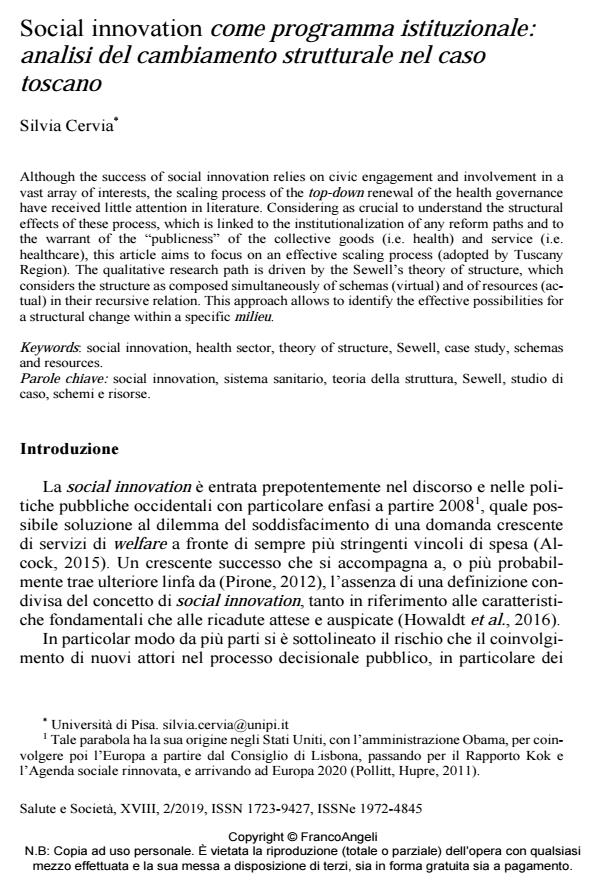Social innovation come programma istituzionale: analisi del cambiamento strutturale nel caso toscano
Journal title SALUTE E SOCIETÀ
Author/s Silvia Cervia
Publishing Year 2019 Issue 2019/2 Language Italian
Pages 13 P. 116-128 File size 164 KB
DOI 10.3280/SES2019-002010
DOI is like a bar code for intellectual property: to have more infomation
click here
Below, you can see the article first page
If you want to buy this article in PDF format, you can do it, following the instructions to buy download credits

FrancoAngeli is member of Publishers International Linking Association, Inc (PILA), a not-for-profit association which run the CrossRef service enabling links to and from online scholarly content.
Although the success of social innovation relies on civic engagement and involvement in a vast array of interests, the scaling process of the top-down renewal of the health governance have received little attention in literature. Considering as crucial to understand the structural effects of these process, which is linked to the institutionalization of any reform paths and to the warrant of the "publicness" of the collective goods (i.e. health) and service (i.e. healthcare), this article aims to focus on an effective scaling process (adopted by Tuscany Region). The qualitative research path is driven by the Sewell’s theory of structure, which considers the structure as composed simultaneously of schemas (virtual) and of resources (actual) in their recursive relation. This approach allows to identify the effective possibilities for a structural change within a specific milieu.
Keywords: Social innovation, health sector, theory of structure, Sewell, case study, schemas and resources.
- Albury D. (2005). Fostering Innovation in Public Services. Public Money & Management, 25(1): 51-56.
- Alcock P. (2015). Editoriale. Salute e Società, 1: 11-15. DOI: 10.3280/SES2015-00100
- Bason C. (2010). Leading Public Sector Innovation. Bristol: Policy Press.
- Bekkers V., Tummers L., Stuijfzand B.G., Voorberg W. (2013). Social innovation in the public sector: An integrative framework. Rotterdam: Erasmus University Rotterdam.
- Callon M. (1986). Some elements of a sociology of translation: Domestication of the scallops and the fishermen of St. Brieuc Bay. In: Law J., a cura di, Power, action and belief. A New Sociology of Knowledge? London: Routledge and Kegan Paul.
- Canale L. (2013). Unione Europea, Innovazione Sociale e Secondo Welfare. WP-2WEL, 1: 1-20.
- Caulier-Grice J., Davies A., Patrick R., Norman W. (2012). Defining social innovation. TEPSIE, European Commission. Brussels: European Commission, DG Research.
- Cesareo V. (2017). Per un welfare responsabile. In: Cesareo V., a cura di, Welfare responsabile. Milano: Vita e Pensiero.
- Dolhinow R. (2010). A Jumble of Needs: Women’s Activism and Neoliberalism in the Colonias of the Southwest. Minneapolis and London: University of Minnesota Press.
- Fagerberg J. (2006). Innovation: A Guide to the Literature. In: Fagerberg J., Mowery D.C., Nelson R., Oxford Handbook of Innovation. Oxford: Oxford University Press.
- Howaldt J., Domanski D., Kaletka C. (2016). Social Innovation: Towards a new Innovation Paradigm. Revista de Administração Mackenzie, 17(6): 20-44.
- Martinelli F. (2013). Learning from case studies of social innovation in the field of social services: creatively balancing top-down universalism with bottom-up democracy. In: Moulaert F., Maccallum D., Mehmood A., Hamdouch A., a cura di, International handbook of social innovation. Social Innovation, Collective Action and Transdisciplinary Research. Cheltenham: Edward Elgar.
- Massey A., Johnston-Miller K. (2016). Governance: public governance to social innovation? Policy & Politics, 44(4): 663-675. DOI: 10.1332/030557314X1404223010959
- Mendes A., Batista A., Fernandes L., Macedo P., Pinto F., Rebelo L., Ribeiro M., Ribeiro R., Sottomayor M., Tavares M., Verdelho V. (2012). Barriers to Social Innovation. Brussels: European Commission, DG Research.
- Moulaert F., Maccallum D., Mehmood A., Hamdouch A. (2013). International handbook of social innovation. Social Innovation, Collective Action and Transdisciplinary Research. Cheltenham: Edward Elgar.
- Mulgan J. (2009). The Art of Public Strategy. Oxford: OUP.
- Novy A., Hammer E., Leubolt B. (2008). Social Innovation and Governance of Scale in Austria. In: MacCallum D., Moulaert F., Hillier J., Vicari Haddock S., Social Innovation and Territorial Development. Farnham/Burlington: Ashgate.
- Pavesi N., Tacchi E.M. (2017). Elementi di innovazione nel “welfare municipale”. In: Cesareo V., a cura di, Welfare responsabile. Milano: Vita e Pensiero.
- Pirone F. (2012). Innovazione sociale: l’estensione semantica di un concetto in ascesa politica. La Rivista delle Politiche Sociali, 4: 137-150.
- Pollitt C., Hupe P. (2011). Talking about Government: The Role of Magic Concepts. Public Management Review, 89(1): 114-127. DOI: 10.1080/14719037.2010.53296
- Santoro M., Sassatelli R. (2008). Introduzione. In: Santoro M., Sassatelli R., a cura di, Studiare la cultura. Nuove prospettive sociologiche. Bologna: il Mulino.
- Sewell W. Jr. (2008). Logiche della storia. Milano: Bruno Mondadori (ed.or.: Logics of History. Social Theory and Social Transformation. Chicago: Chicago University Press, 2005).
- Simon J., Davies A. (2013). People Powered Social Innovation: The Need for Citizen Engagement. Social Space, 38-43.
- Swyngedouw E. (2009). Civil society, governmentality and the contradictions of governance-beyond-the-state: The janus-face of social innovation. In: MacCallum D., Moulaert F., Hillier J., Haddock V.S., a cura di, Social Innovation and Territorial Development. Farnham: Ashgate Publishing Ltd.
- Whitley R.D. (1972). Black Boxism and the Sociology of Science: A Discussion of the Major Developments in the Field. In: Halmos P., Albrow M., a cura di, The Sociology of Science. Keele: University of Keele.
Silvia Cervia, Social innovation come programma istituzionale: analisi del cambiamento strutturale nel caso toscano in "SALUTE E SOCIETÀ" 2/2019, pp 116-128, DOI: 10.3280/SES2019-002010